How Many Pounds of Flour or Wheat to Make Loaves of Bread
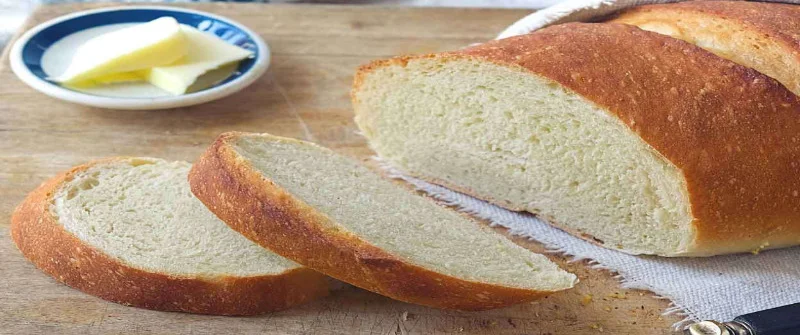
The focus of this article is how much flour you would need to make a loaf (or loaves) of homemade bread. Also, how many pounds of flour (or wheat) you would need, based on the number of loaves per week, and the number of months to store ahead.
I have updated this article a few times. A recent update added a chart/table which some of you may appreciate. It illustrates the number of loaves of bread per week from 1 loaf a week to 7 loaves a week, versus storing enough flour for 1, 3, 9, or 12 months. It adds up fast!
Some time ago I polled our audience to discover how many loaves of bread they consume each week in their household. Based on the results we can work out a few things for general preparedness.
1. How much flour storage to make your own bread
2. How much wheat storage to make your own bread
From those who responded to the poll, the majority go through 1 loaf of bread each week.
1.0 loaf (64%)
1.5 loaves (19%)
2.0 loaves (8%)
2.5 loaves (5%)
3+ loaves (4%)
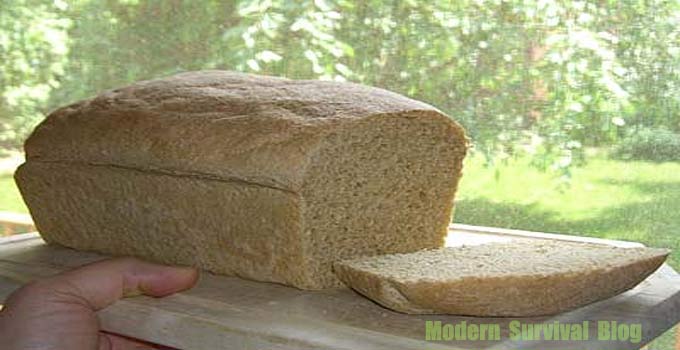
Pounds of Flour To Make Bread
The following is the approximate number of pounds of FLOUR that you will need:
Numbers are rounded up:
3 months of flour storage to make bread at home
1 loaf per week = 12 pounds of flour (3) 5-pound bags
2 loaves per week = 23 pounds of flour (5) 5-pound bags
3 loaves per week = 35 pounds of flour (7) 5-pound bags
1 year of flour storage to make bread at home
1 loaf per week = 51 pounds of flour (10) 5-pound bags
2 loaves per week = 101 pounds of flour (20) 5-pound bags
3 loaves per week = 152 pounds of flour (30) 5-pound bags
(keep reading for pounds per loaf, and loaves per pound)
TIP!
We’ve been using these Rubbermaid airtight storage containers which perfectly hold 5 pounds of flour, with a bit of room to spare. Very convenient!
Though the apparent semi-official number is 18-cups of flour in a 5-pound bag, it’s relative, depending on how tightly or loosely the flour is packed. Typically flour is packed pretty dense, and a 5-pound bag (or milled yourself) easily fits in the following 16-cup container (They make an 18 too).
16-CUP Airtight Container
(amzn)
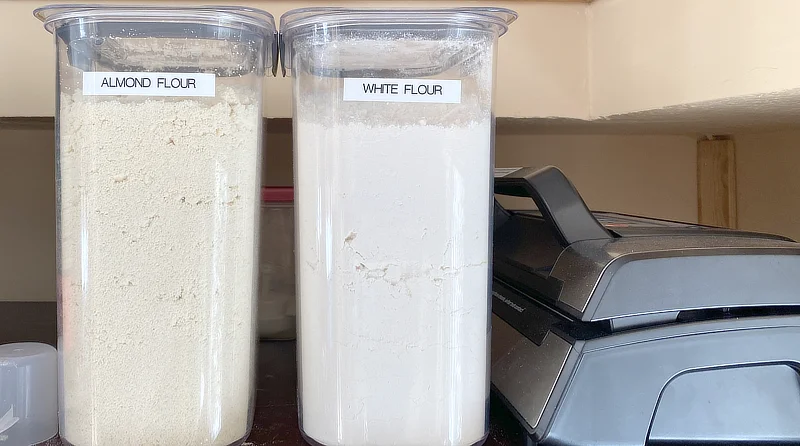
How many loaves of bread will 5 pounds of flour make?
- about 5 loaves
How many pounds of flour in a loaf of bread?
- about 1 pound
This will vary a bit, depending on your bread loaf size. However, for my homemade bread, a good estimate is 1 pound of flour per loaf. That’s a good size loaf of bread using about 3.5 cups flour! We also make slightly smaller loaves using about 2.5 cups instead. But for a good ‘rule of thumb’, you might say 1 pound per loaf.
During a recent update, I added more data to include scenarios of making lots more bread. Why? Because although the average number of bread loaves (according to the reader poll) is only between one and two loaves per week, a time during ‘collapse’ (SHTF?) may or will result in more loaves of bread, assuming you’ve stored enough wheat/flour.
Note that the assumption here for this data is 1 LB flour per loaf of bread.
Factoid: There are approximately 18 cups of flour in a 5 LB bag (more like 16 – 18 in real life).
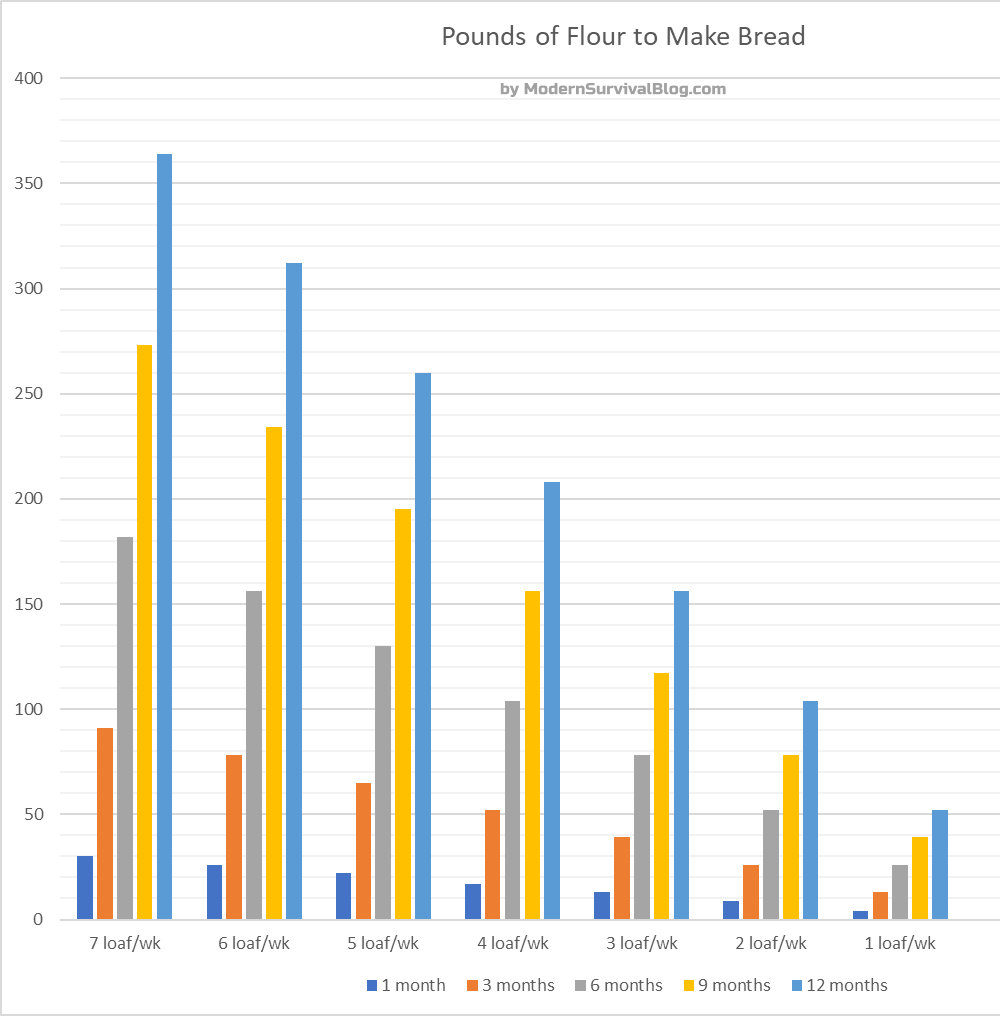
Pounds Of Flour To Store versus #Bread-Loaves & Months of Storage
| 7 loaves/wk | 30 | 91 | 182 | 273 | 364 |
| 6 loaves/wk | 26 | 78 | 156 | 234 | 312 |
| 5 loaves/wk | 22 | 65 | 130 | 195 | 260 |
| 4 loaves/wk | 17 | 52 | 104 | 156 | 208 |
| 3 loaves/wk | 13 | 39 | 78 | 117 | 156 |
| 2 loaves/wk | 9 | 26 | 52 | 78 | 104 |
| 1 loaf/wk | 4 | 13 | 26 | 39 | 52 |
| months | 1 | 3 | 6 | 9 | 12 |
[ Read: Food Storage For 1 Year ]
Pounds of Wheat Berries for DIY Homemade Bread
Wondering how much wheat to make a loaf of bread? If you mill your own flour, here are some numbers to give you a good idea…
The following are the approximate pounds of WHEAT BERRIES you will need:
3 Months of Wheat Berries Storage to make homemade bread
(loaves per week = lbs of wheat)
1 = 12 pounds of wheat berries
2 = 25 pounds of wheat berries
3 = 37 pounds of wheat berries
1 Year Wheat Berries Storage to make homemade bread
(loaves per week = lbs of wheat)
1 = 54 pounds (1.6) 5-gallon buckets
2 = 108 pounds (3.3) 5-gallon buckets
3 = 162 pounds (4.9) 5-gallon buckets
Note: Wheat berries versus milled flour for long-term storage. Wheat berry’s shelf life will be decades if stored properly. Wheat berries can easily be stored for 20+ years (and longer!) if stored properly. Once wheat is milled into flour, the rule of thumb is you’re looking at about 1 year (more or less) for optimum results.
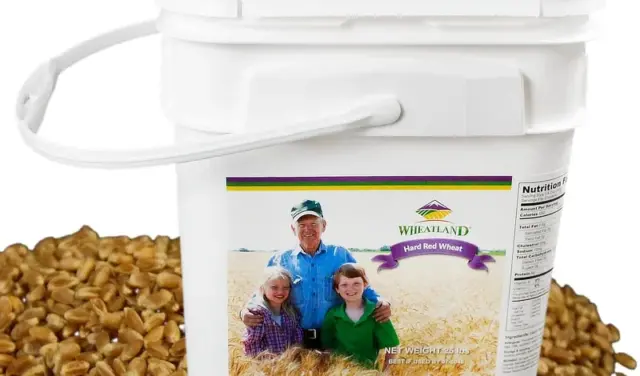
Hard White Wheat Berries (25-pounds)
Hard White Wheat Berries (25-pounds)
(view on amzn)
Electric flour mill:
Wondermill Electric Grain Mill
My hand grain mill:
Country Living Mill
[ Read: Choosing The Best Hand Grain Mill (Flour Mill) ]
Weights & Measures
The following are my measured quantities:
5.2 ounces of flour per cup
6.65 ounces of wheat berries per cup
3 cups flour for a typical homemade bread loaf
2.5 cups wheat berries mill to approx. 3 cups flour
15.6 ounces of flour per loaf
16.6 ounces of wheat berries per loaf
33 lbs wheat berries 5-gallon bucket
79 cups wheat berries in 5-gallon bucket
25 to 32 loaves of bread per 5-gallon bucket (depending on the loaf)
How Many Loaves of Bread Every Week?
[ Read: An Electric Flour Mill For Your Own Homemade Breads ]
